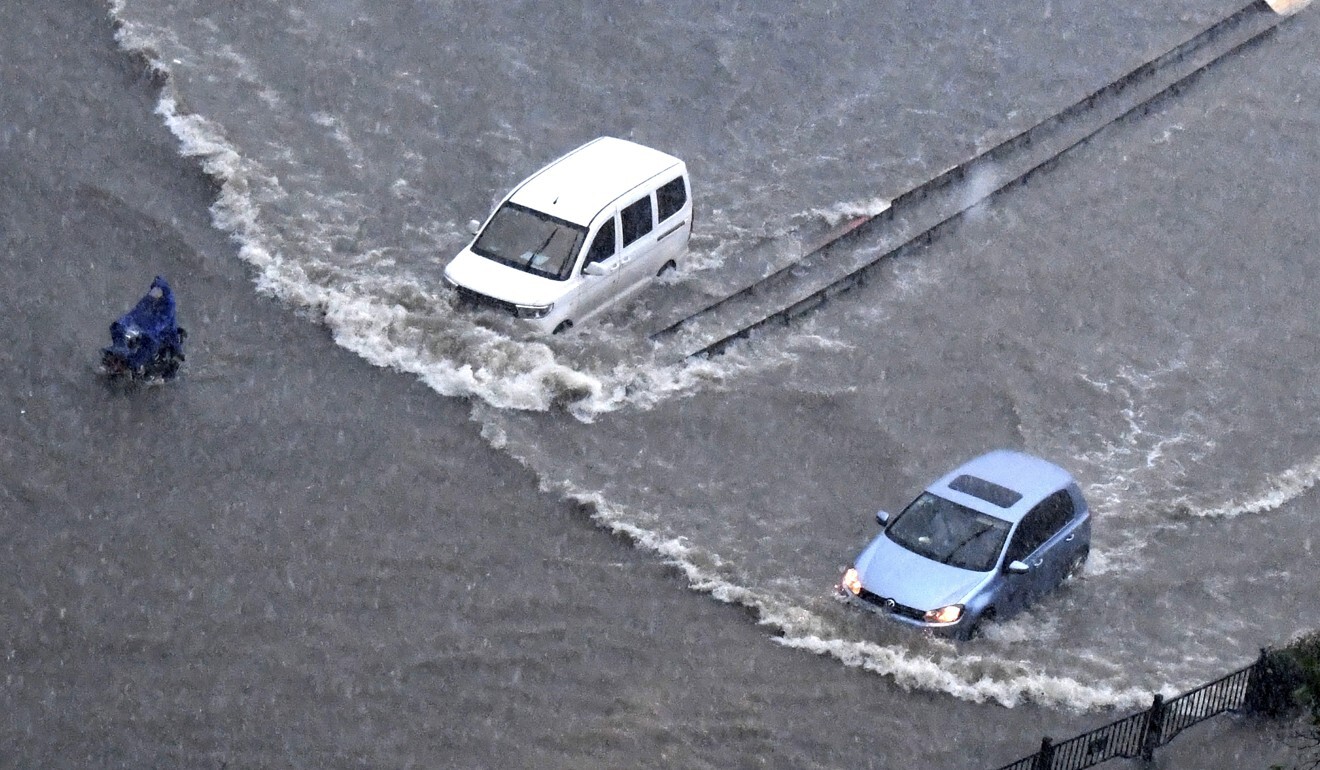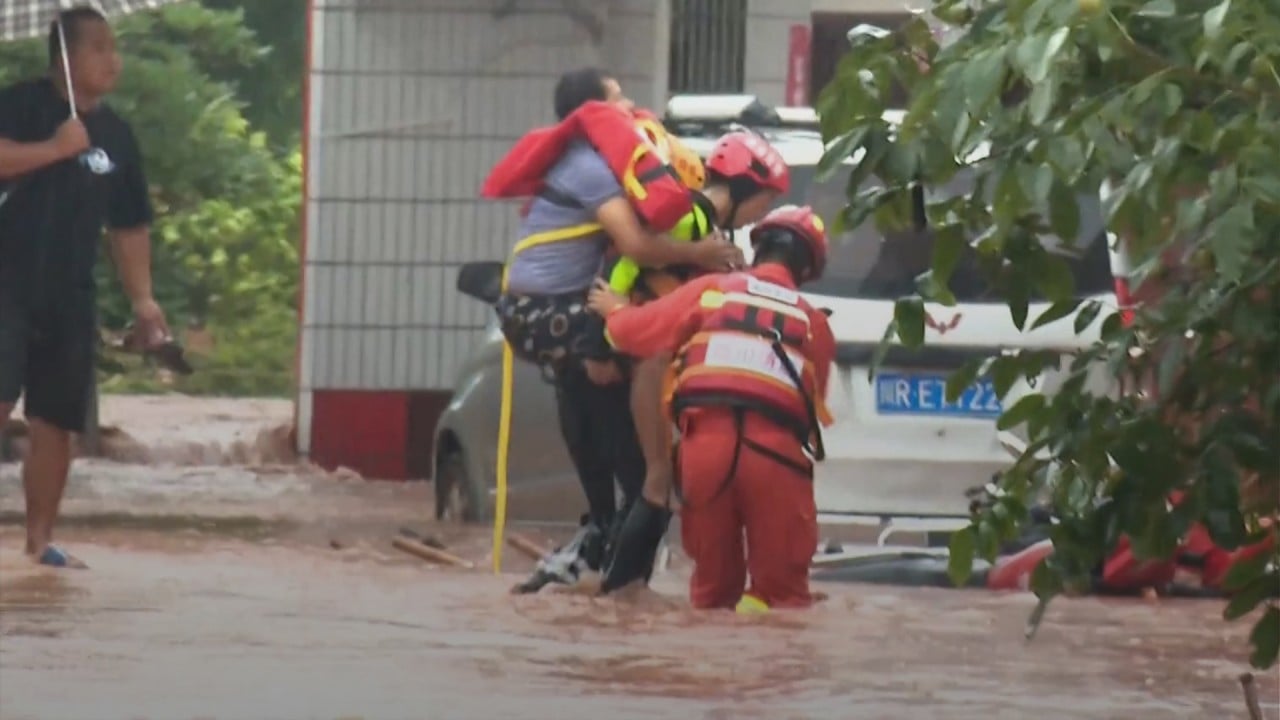
Devastating China floods caused by Typhoon In-fa’s airflow hitting area of high pressure, say experts
- The two meteorological phenomena combined over Zhengzhou with devastating consequences
- The problem was compounded by the surrounding mountains that trapped atmospheric vapour over the city, on the banks of the flood-prone Yellow River
The central Chinese city of Zhengzhou was hit by devastating floods as the result of the airflow from Typhoon In-fa hitting an area of high pressure centred on the Pacific, according to meteorologists.
The typhoon combined with the Western North Pacific Subtropical High to create a stable airflow that carried large quantities of atmospheric water towards Henan province, Chen Tao, chief forecaster of the National Meteorological Centre, said on Wednesday.
According to the provincial meteorological bureau, the phenomenon was compounded by Zhengzhou’s topography.
The city on the banks of the Yellow River – the site of devastating floods throughout Chinese history – is surrounded by the Taihang and Funiu Mountains which cause wet air to rise and form clouds and intensify the rainfall.
This week’s heavy floods killed at least 25 people and displaced 1.2 million in Henan, with further rains forecast for the next 24 hours.

03:55
Heavy floods in central China kill at least 18 people, force 200,000 from their homes
The Western North Pacific Subtropical High is an atmospheric phenomenon that regulates the East Asian climate in summer. Anomalies in it have been linked to floods, droughts and heatwaves in the past.
Cheng said it was further north than usual at present, meaning Henan was on the edge of the area of high pressure that caused atmospheric moisture to build up, eventually leading to heavy rainfall.
“The position of the subtropical high is relatively to the north and Henan is on the edge of the pressure, bringing strong convection and … heavy rainfall,” Chen said. Typhoon In-fa, which is expected to make landfall in mainland China on Sunday, was a tropical depression in the Philippine Sea last week but intensified and became a typhoon on Tuesday evening.
China’s Big Tech rush to support flood relief in central China
Other parts of China, including Shanghai, Zhejiang and Fujian, are braced for the typhoon’s arrival and have warned of days of heavy rain and strong winds, but the particular circumstances that caused the intense rainfall in Zhengzhou are not expected to occur elsewhere.
In-fa was 680km (420 miles) east of Taipei at noon on Wednesday, moving west-northwest at a speed of 11km per hour, according to the Central Weather Bureau in Taiwan. It had a radius of 180km on Wednesday morning and was carrying maximum sustained winds of 126kph, with gusts of up to 162kph.
The Henan meteorological bureau forecast that downpours in the province would stop as Typhoon In-fa headed towards China because the movement would alter the air circulation and cut off the source of water vapour.
In-fa is likely to move to the south of the East Sea on Friday and make landfall two days later in the eastern province of Zhejiang, according to the Shanghai meteorological bureau.

“[We] cannot eliminate the meteorological phenomena that cause disasters, be they typhoons or extreme weather. Especially in the current situation where global climate has changed, the disaster response is crucial,” said Liu Junyan, the climate and energy project leader for Greenpeace East Asia’s Beijing Office.
Liu said cities should improve their early warning systems and forecasting and ability to identify risk.
“From early warnings and forecasts to coordination and cooperation among government departments, there is a huge gap needing to be bridged,” she said.
Zhengzhou’s meteorological bureau used a common Chinese figure of speech to describe the heavy rain in the city as the worst in 1,000 years.
Detailed records show it was the worst in decades. The maximum precipitation in Zhengzhou reached 201.9mm per hour on Tuesday, breaking the previous record of 198.5mm reported in 1975, according to the national meteorological observatory. The 617.8 mm precipitation recorded in the past three days in the city was the heaviest in 60 years.
“The intensity is unprecedented,” said Chen, adding that heavy rain would continue in Zhengzhou and neighbouring parts of Henan for the next 24 hours.
“Extreme heavy rainfall and extreme heatwaves are common problems faced around the globe,” he said.
Previous studies have linked rising sea surface temperatures to more intense typhoons.

02:03
Thousands displaced by heavy rains and floods in southwest China’s Sichuan and Chongqing
Data from the US National Oceanic and Atmospheric Administration shows that the average global sea surface temperature has increased by about 0.13 degrees Celsius every decade over the past 100 years.
Researchers at the University of California San Diego found that over the past four decades, typhoons hitting East and Southeast Asia have intensified by 12 to 15 per cent, with the number of category 4 and 5 storms – the two highest levels – having doubled or tripled.
The trend is linked to higher temperatures on the ocean surfaces around East and Southeast Asia, according to the study published in Nature in 2016.
The researchers also warned: “The projected ocean surface warming pattern ... suggests that typhoons striking eastern mainland China, Taiwan, Korea and Japan will intensify further.”
China floods: rail passengers tell of rising water and last goodbyes
“The changes in typhoons are largely due to the rise in the sea surface temperatures,” said Greenpeace’s Liu.
“Higher sea temperatures can continuously provide heat and water to intensify the typhoons.”
But Liu added there was no obvious trend of increased flooding caused by typhoons in China.

